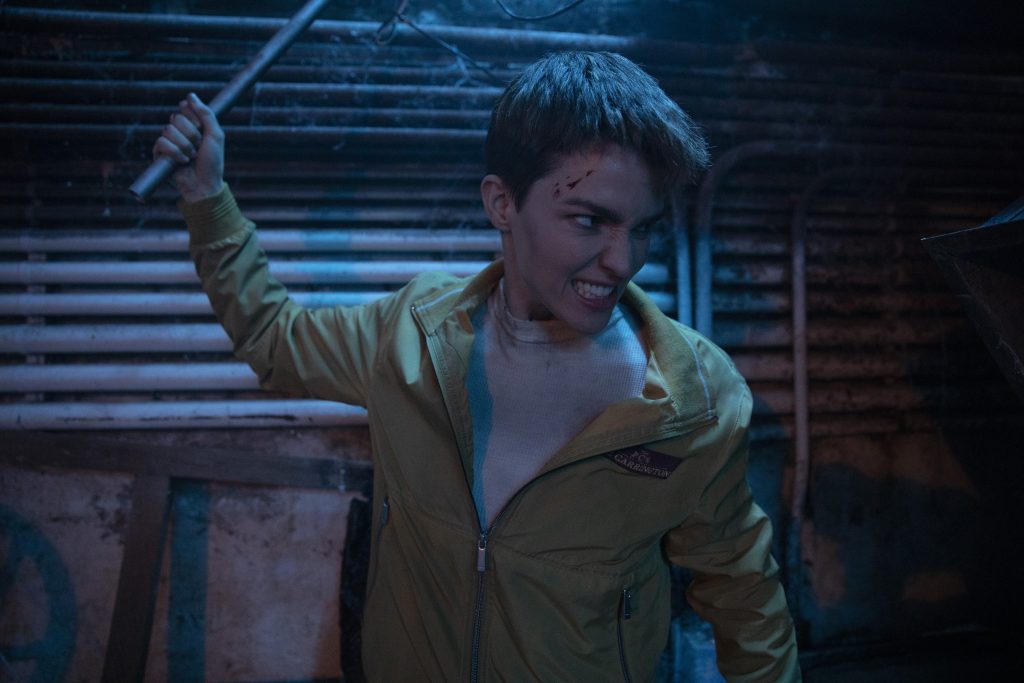March 6, 2023
by Carla Hay

Directed by Adrian Langley
Culture Representation: Taking place in an unnamed city in Germany during World War I, the horror film “Bunker” features a nearly all-white cast of characters (with one Latino) representing the working-class and middle-class.
Culture Clash: A group of American and British military men find themselves trapped in a bunker with a mysterious German soldier, and it isn’t long before they find out that something evil is lurking in the bunker.
Culture Audience: “Bunker” will appeal primarily to people who are interested in watching horror movies that take place during a war, no matter how poorly made and dull the movies are.

An evil creature isn’t the only thing that’s hiding in the World War I horror movie “Bunker,” because a good story and credible acting are nowhere to be found in this dreadfully dull misfire. The last 15 minutes of the movie are especially awful. The vast majority of “Bunker” is an unimaginative and repetitive depiction of World War I soldiers trapped in a bunker and being in various states of denial that something evil is lurking in the deep recesses of the bunker. At various times, some of the trapped military men start vomiting up a milky white substance, which is supposed to be scary, but it just looks like they have dairy indigestion.
Directed by Adrian Langley and written by Michael Huntsman, “Bunker” is a movie based on a half-baked idea that obviously got made into a movie because the filmmakers had nepotism connections. Michael Huntsman’s father, James Huntsman, who is one of the movie’s producers, owns Blue Fox Entertainment, the distributor of “Bunker.” It’s not that original to do a horror movie about people being trapped somewhere with something evil, but some not-very-original horror movies that have this concept end up being noteworthy because the story is genuinely scary and well-crafted. Unfortunately, “Bunker” has none of the qualities that could have made it an entertaining thriller.
“Bunker” (which takes place an unnamed city in Germany during World War I) is filled with a lot of cringeworthy dialogue and even worse acting. (“Bunker” was actually filmed in Buffalo, New York.) It’s a story so poorly conceived, limited in scope, and shallow, it’s barely enough to make a short film. Instead, viewers will have to sit through 108 minutes of watching military men trapped in a bunker and doing the stupidest things possible in their attempts to escape.
The military men, who are British and American, are trapped in this bunker after going on a mission to No Man’s Land to attack Germans. There’s no explanation for why this military unit is a mixture of British and Americans. The unit’s leader is Lieutenant Turner (played by Patrick Moltane), a pompous Brit who acts like a know-it-all when he’s actually the one who shows the least common sense. Moltane’s acting, which is very hammy yet stiff, is easily the worst in this movie that’s a cesspool of mediocre-to-terrible performances.
The men under Turner’s command are Private Segura (played by Eddie Ramos), a courageous medic from the U.S. 90th Infantry Division the U.S. Army; Private Baker (played by Julian Feder), a terrified American teenager, who has recently joined the military; Private Gray (played by Michael Mihm), a racist British bully; Private Lewis (played by Quinn Moran), a very religious Brit; and Lance Corporal Walker (played by Adriano Gatto), a paranoid American.
Before getting trapped in the bunker, Segura and Baker had a harrowing experience above ground, when Baker was attacked by a German soldier (played by Samuel Huntsman), who appeared to be dead on a battlefield. Segura came to the aid of a wounded Baker, who stabbed the attacker to death in self-defense. It’s the first time that Baker has killed someone, and he is haunted by the experience.
However, the movie deals with this trauma in glib and superficial soundbites. Later, when Baker confides in Segura about how much this killing is disturbing Baker, this is Segura’s response: “Compassion is lost in conflict. It’s you or them.” Baker then says of war combat, “I just shouldn’t be so thoughtless.” It’s an example of the movie’s atrocious dialogue.
The men find the bunker, but get trapped inside when bombing above ground causes an avalanche of rocks to block the bunker entrance. There’s a radio inside the bunker, but Turner gets angry when Segura uses the radio try to call for help. Turner shouts at Segura: “You’re not here to think! You’re here to follow my orders!”
Turner says that calling for help is “sacrificing our defenses,” because it could alert the enemy. Instead, Turner’s plan to escape is for the men to randomly dig an underground tunnel, even though they have no idea where the digging will lead. The digging is also counterproductive, because they need to go above ground, not further underground.
Meanwhile, the men find out that there’s someone else who’s already in the bunker: a barely conscious German soldier named Kurt (played by Luke Baines), whose hands have been nailed to a cross. The men remove Kurt from this crucifix and try to get him to talk. Segura gives Kurt medical aid. At first, Kurt stays mute and pretends that he doesn’t know English. Eventually, Kurt stops this charade and begins communicating in English, mostly with Segura.
The movie has a foreshadowing of the mayhem to come before the men go on their unlucky trek to No Man’s Land. Gray tries to scare Baker by ominously saying that there’s a legend that the ghouls of No Man’s Land will kill people: “They’re not afraid to fill the trenches, looking to fill their bellies with the tastiest meat.” And in case it isn’t made clear that Gray is a racist, he calls Segura a “greaser” and treats Segura with disdain.
The visual effects in “Bunker” are straight out of the Corny Horror Movies Handbook: As soon as the men get trapped in the bunker, a mysterious cloud of smoke suddenly appears and seems to be moving in their direction. A milky white substance keeps getting vomited up by some of the men. One of the men vomits up this milky white substance that’s mixed with something resembling a deformed squid, but dimwit leader Turner keeps denying that something is seriously wrong.
Meanwhile, the men soon run low on food and water. The only rations found in the bunker are grossly spoiled and inedible. In this dire situation, Turner (like a fool) orders the men to keep digging, when the men should be using their energy for a better escape plan. Kurt is usually shown smirking and giving creepy stares, which make it obvious that Kurt knows more than he’s telling.
Segura secretly continues to use the radio to call for help, and he makes contact with a British military officer. But viewers who are good at voice recognition can easily tell who’s behind the voice that’s communicating with Segura, who apparently is too dimwitted to notice. Therefore, when something is revealed about the radio, it should come as no surprise. And during this crisis, Segura makes time to write in his journal, which is supposed to add gravitas to the last shot in the movie.
“Bunker” is a slog of tired horror clichés of shallow characters trapped somewhere, with predictable conflicts and deaths. The movie has a melodramatic musical score that’s supposed to evoke movie thrillers of the World War I era, but this music just sounds bombastic and overly contrived. Segura is obviously supposed to be the most heroic person in the group (and Ramos is adequate in his efforts to make this character believable), but there’s no character development or real insight into anyone in “Bunker.”
The film editing of “Bunker” is often sloppy, while the movie’s cinematography has very inconsistent lighting that blinks at certain moments, in the movie’s lukewarm attempt to create a foreboding atmosphere. The movie’s cinematography often makes the bunker look more like a kiddie haunted house instead of a genuinely terrifying place. “Bunker” makes no effort to craft a cohesive story or interesting personalities for these characters. As for the evil lurking in the bunker, don’t expect an explanation for it either—just like there’s no good explanation for why this movie exists, except as an example of how nepotism in the movie industry can sometimes result in bad movies getting made.
Blue Fox Entertainment released “Bunker” in select U.S. cinemas on February 24, 2023.




